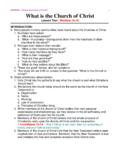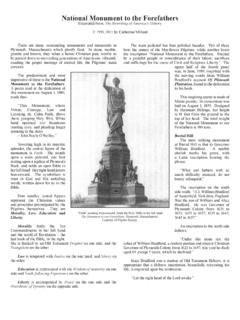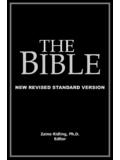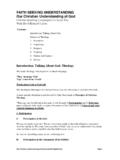Transcription of Edited by John Nicholas Lenker Translated by John …
1 Edited by john Nicholas LenkerTranslated by john Nicholas Lenker and othersVOLUME 1 SERMONS ON GOSPEL TEXTSFOR ADVENT, CHRISTMAS, AND Editor s IntroductionDedication to Frederick, the ElectorIntroduction to Volumes 1 and 6 First Sunday in Advent, <402101>Matthew 21:1-9 Christ Enters Jerusalem: or Faith; Good Works; and the SpiritualMeaning of This Sunday in Advent, <422125>Luke 21:25-36 Christ s Second Coming: or the Signs of the Day of Judgment; and theComfort Christians Have from Sunday in Advent, <401102>Matthew 11:2-10 john in Prison: or Christ s Answer to john s Question;His Praise of john ; and the Application of This Sunday in Advent, <430119> john 1:19-28 The Witness and Confession of john the Baptist; and the SpiritualMeaning of His , <420201>Luke 2:1-14 The Story of the Birth of Jesus; and the Angels Christmas Day, <420215>Luke 2:15-20 The Fruits and Signs of the Power of the Word of Christmas Day, <430101> john 1:1-14 Christ s Titles of Honor; His Coming; His Incarnation; and theRevelation of His Stephen s Day, <402334>Matthew 23:34-39 The Christian Teaching Concerning Reason and of St.
2 john the Evangelist, <432119> john 21:19-24 Everyone Should Honor His Calling and Be Content in After Christmas, <420233>Luke 2:33-4 Simeon; Anna; and the Childhood of Year s Day, <420221>Luke 2:21 The Circumcision and Naming of , <400201>Matthew 2:1-12 The Story and Spiritual Meaning of This sending forth this the first English translation of Luther s Advent,Christmas and Epiphany sermons of his Church Postil on the Gospels, wegratefully record our hearty thanks to the following and all others whohave so promptly and cheerfully extended their aid in trying to give to theEnglish speaking world a classic translation of the classics ofProtestantism : To Rev. E. H. Caselmann, Secretary of the German IowaSynod, for translating the sermon of the first Sunday in Advent; to Ackermann, Ph. D., Lima, Ohio, for the sermon of the second Sundayin Advent; to Rev. E. Gerfen, Gibsonburg, Ohio, for the sermon of thethird Sunday in Advent; to Prof.
3 Hans Juergensen, of the GermanDepartment of the University of Minnesota, for the sermon of the fourthSunday in Advent; to Rev. Geo. H. Trabert, D. D., Minneapolis, for thesermon of the first Christmas Day; to Rev. john Sander, late professor ofGerman in Gustavus Adolphus College, St. Peter, Minn., for the sermon ofthe third Christmas Day; to Rev. B. Lederer, Chicago, for the sermon ofthe Sunday after Christmas; and to A. G. Voigt, D. D., Pres. TheologicalSeminary, Mt. Pleasant, S. C., for the New Year s sermon. The followingbrethren Translated the Epiphany sermon or treatise: Rev. E. Gerfen, 1-79; Rev. E. H. Caselmann, 80-112; Rev. S. Schillinger, WestAlexandria, Ohio, 113-225, and Prof. W. A. Sadtler, Ph. D., WartburgSeminary, Dubuque, Iowa, , Minnesota, December 21, N. S is in place here to give an accurate, comprehensive and chronologicalhistory of Luther s Church Postil. In its composition and publication weare to distinguish four periods in its development.
4 The first period is thatfrom 1520 to 1527 when Luther himself wrote out his sermons andgenerally prepared them for the printer. The second period is that from1527 to 1535 when the work of Rodt as editor is prominent. During thethird period from 1540 to 1544 Creuziger is the editor. The fourth periodincludes all the editorial work on the Church Postil after Luther s The Church Postil, which Luther himself considered The best of all hisbooks, was called forth by the exigency and need of the Church at thetime. The majority of the preachers in those days were incapable ofworking out their own sermons, and were satisfied in reading the Epistleand Gospel lessons, and perhaps besides they read a sermon of anotherpreacher to the congregation. The sermons for this purpose were those byTauler (d. 1361) and those by Geiler of Kaisersberg (d. 1510). But sincethe latter were not in all parts evangelical Luther concluded he wouldhimself write an explanation of the pericopes of the Church year and placethe same in the hands of the preachers for their use.
5 This Luther did notonly because the preachers were so incompetent, but also in order toprevent the work of the fanatics and the sects, never however in order toencourage preachers in their laziness to take their sermons from his andother good books, and then never pray, never study and never read andsearch the occasion for writing this work, however, was given by the ElectorFrederick the Wise requesting Luther in 1520 to prepare a Postil for all theSundays, especially for the season before Easter. At the same time hedesired thereby to draw Luther from his many disputes to the positiveteaching of the Gospel and this Luther knew. In 1521 his Advent Postilappeared at Wittenberg in Latin. It was Translated at once into German (butnot by Luther), and it appeared in 1522 under the title: Postil orExplanation of the Epistles and Gospels for Advent. Interrupted by his journey to Worms Luther resumed the work on theWartburg and labored there on the Christmas sermons.
6 He was againinterrupted by the Carlstadt disorder. Sept. 17, 1521, however the Postil7was finished to Epiphany. This second part was Completed in the Desert(on the Wartburg) St. Elizabeth s Day (Nov. 21) 1521. With it appearedthat classic document A Short Instruction as to What We Are to Seek andExpect In the Gospel. In 1525 the sermons from Epiphany to Easterappeared. Bucer Translated this Winter Postil into Latin for the friends ofthe Gospel in Italy, which appeared in five books in Strassburg complete Latin Postil was issued in 1530 and 1535 in Strassburg, anda new edition in 1617 at of sermons for the summer season and for the Church festivalswere early issued which were later embodied in the Church Postil. Theywere:1. Fourteen Fine Christian Sermons, Preached at Wittenberg in , The Use We are to Make of the Sufferings of Christ, Basel, Twenty-Seven Sermons, Strassburg, 1523. 3. Thirteen Sermons, 1523.
7 A Supplement to the Twenty SevenSermons. 4. Twelve Sermons For Certain Festivals of the Saints. Luther being engaged from 1527 by other labors Rodt of Zwickauedited the Summer Postil and the Postil for the Chief Festivals, which wereprinted at Wittenberg in 1527, along with Bugenhagen s Summariestranslated from the Latin. Here the Epistles are omitted. In 1528 he alsoprepared a new edition of the Winter Postil, further revised by three books, prepared by Rodt, were reissued at Wittenberg in 1527,1528, 1529, 1530, 1531, 1532, 1533 and 1535; the Winter Postil ninetimes, the Summer Postil eight times, the Festival Postil four times. In hiseditorial work Rodt omitted some and added other material; now and thenhe united two sermons into one and divided one into two sermons. For thisFriedrich Francke no doubt criticised him too severely. True, later Lutherwas not fully satisfied with Rodt s work, but he was not pleased with hisown and hence he continually corrected it.
8 According to Luther s opinionRodt corrected too little. Creuziger was appointed by Luther to prepare anew edition of the Postil with many marked In an essentially changed form the Church Postil was Edited byCreuziger at the close of Luther s life work, from 1540 to 1544, under8 Luther s supervision. In 1540 there was printed at Wittenberg, TheExposition of the Epistles and Gospels from Advent to Easter. By Luther. Revised with a Useful Index. It was again issued in 1544 appeared the new edition, revised by Creuziger, of TheExposition of the Epistles and Gospels from Easter to Advent. Dr. MartinLuther. New Edition. Thus the whole Church Postil was corrected andrevised, and printed first at Leipsic and then at Wittenberg in 1544 underthe title, The Exposition of the Epistles and Gospels for the Whole Martin Luther. Lately revised, with a Useful Index. It containedForewords by Luther and by Creuziger. The winter part was revised mostlyby Luther.
9 He corrected the text of other editions, shortened somesermons, omitted parts and added new the same way according to Luther s direction and appointmentCreuziger revised the summer part and as Luther says, He enlarged andimproved it. Often he took Rodt s editions and so thoroughly changedthem that they appeared like a new production. Many other sermons eitherhe or some one else took down in writing while Luther preached ordictated them. It is difficult to determine which sermons are from Rodt asto contents, style and rhetoric. Creuziger modified the strong language ofLuther often developed the short, condensed sayings of Luther accordingto his own taste, and made corrections where they were, and were not, inplace. These sermons of Creuziger s summer part are easy and pleasantreading, but they bear a different stamp from the sermons Luther himselfspoke word for word. What and how much of the Church Postil of 1544originated with Luther, where the additions by Creuziger begin and end isvery difficult to determine and After Luther s death, in the 16th and 17th centuries, the Church Postilwas often, and mostly according to the text of 1543, printed at Wittenbergand other places.
10 But it was changed even more, and often twisted andaltered in the interests or certain dogmatical tendencies. In the firstcomplete edition of Luther s works neither the Church nor the HousePostil was Spener who resolved to give this excellent work of Luther s into thehands of the Church in its original purity, and he prepared a new edition inorder to place before the diligent reader the Postil in its most completeform, so that he might receive an idea, not only how it was published atthis or that time, but that at one view it may appear in its various forms,9with this difference that the reader may at the same time see what wasadded or subtracted at different times. Spener took as the basis for thepreparation of his editions the editions of 1528, 1532 and is here worthy of note that Spener (b. 1635, d. 1705), the father ofGerman Lutheran Pietism and honored so highly in America and allProtestant lands, was the first to issue a critical edition of Luther s ChurchPostil.






